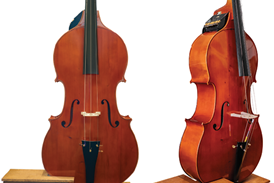Tully Potter reviews Leah Broad’s account of the lives of four pioneering women in music: Ethel Smyth, Rebecca Clarke, Dorothy Howell and Doreen Carwithen

Quartet: How Four Women Changed the Musical World
Leah Broad
480PP ISBN 9780571366101
FABER & FABER £20
The Quartet of Leah Broad’s title is not a female chamber ensemble but a cobbled-together group of British women composers who had relatively little in common, as far as I can see: Ethel Smyth (1858–1944), Rebecca Clarke (1886–1979), Dorothy Howell (1898–1982) and Doreen Carwithen (1922–2003).
Normally when reviewing a book, I fill about a quarter of an A4 sheet with notes; if I tell you that on this occasion I filled almost a whole sheet, you will gather that this tome has caused me some disquiet. Two major irritations come from Broad’s clumsy interleaving of the four lives and her use of ‘Ethel’, ‘Rebecca’, ‘Dorothy’ and ‘Doreen’ for her subjects. Henry Wood even gets referred to as ‘Henry’ most of the time. Would Ms Broad expect me to call her ‘Leah’ in this review?
To be positive, I think she gets Ethel Smyth right to a great extent and the book can be recommended as a latter-day view of this great composer and battler for women’s rights. She is also very good on the last phase of Rebecca Clarke’s life, when she found happiness with the pianist and composer James Friskin.
She does not persuade me that Howell was more than very small beer as a creative artist, although no doubt an admirable human being. And about Carwithen, whom I knew as Mary Alwyn, there is a consistent undercurrent suggesting that her talent was repressed by the great love of her life, William Alwyn. In truth, the first time I met the Alwyns he was at pains to stress that Mary was also a fine composer; and she willingly gave her energies to propagating his music, before and after his death.
Book review: Pioneer Violin Virtuose in the Early Twentieth Century
Book review: The Sound of Memory: Themes from a Violinist’s Life
Book review: Maud Powell: Pioneer American Violinist
Broad seems uncertain of her target audience. Do we need to have ‘libretto’, ‘in nomine’, ‘boatswain’, Gilbert and Sullivan, The Dream of Gerontius, Tallis and Bechstein explained to us? She writes of ‘a choral Mass’. The paragraph about Elgar on page 134 is grotesque. She writes of ‘a pianist called Kathleen Long’ and ‘a conductor called Dan Godfrey’ – both were well known – and has America entering the Great War in 1918, also mixing up the V1 and V2 in World War II.
The writing is often poor. The words disinterest, wracked, lollop and becalmed are misused. We get ‘hinges around’, ‘pedestalised’, ‘ostracisation’, ‘educationalist’ and ‘workshopped’. Mills and Boon-style drivel abounds. We first meet Howell, aged seven, kneeling ‘on the cool flagstone floor of St Francis’s Catholic Church’ – I spent hours of my childhood kneeling on Roman Catholic church floors and it was dashed uncomfortable.
Instead of what she obviously thinks is ‘fine writing’, she could have told us more about the musicians who performed her subjects’ music. She even describes people without naming them. In 1920 Clarke miraculously plays her Viola Sonata on her own in New York (in reality the distinguished Scots pianist Winifred Christie partnered her). No mention is made of Clarke’s only recording – a fine Mozart ‘Kegelstatt’ Trio with Long and Frederick Thurston – or of Aubrey Brain, for whom the horn part in Smyth’s superb 1927 Double Concerto was specifically designed.
Try as I may, I cannot see Howell, Carwithen or even Clarke as world changers, despite their various virtues. Ethel Smyth is a different matter and, praise be, she has now emerged from the dip in interest that usually follows a composer’s death (Chopin is the sole exception I can think of). The book is nicely produced and illustrated, with an index and a select discography of the four women’s music.
TULLY POTTER









































1 Readers' comment